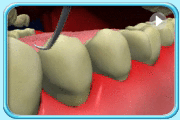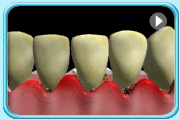Root planing is a method of treating severe gum disease. When having gum disease, inflammation of the tissues will lead to separation of gum from the root surface, which creates a tiny space known as a periodontal pocket. It can be very difficult to keep clean and allows bacteria to accumulate. Root planing is the meticulous cleaning of root surfaces to remove dental plaque and calculus.
Remove the dental plaque and calculus on the root surface inside periodontal pocket in order to get rid of the bacteria that cause gum disease. It helps to reduce inflammation and allows the gum diseases to be recovered.
People with severe gum disease need to receive treatments of scaling and root planing. Before carrying out treatment, the dentist will use a periodontal probe and take radiographs to confirm the severity of gum disease. The dentist will also let the involved area be numbed by using anaesthesia to reduce discomfort during treatment. Instruments called curettes or ultrasonic cleaners will be used to remove the plaque and calculus on root surface in the periodontal pocket.

If needed, the dentist may perform periodontal surgery that flips the gum, exposing the root surface. Then the dentist can clean the root surface with direct vision.
